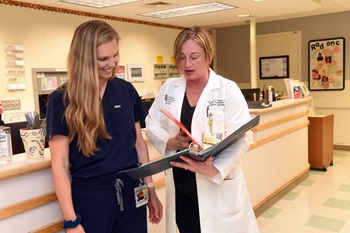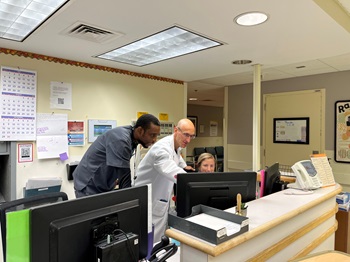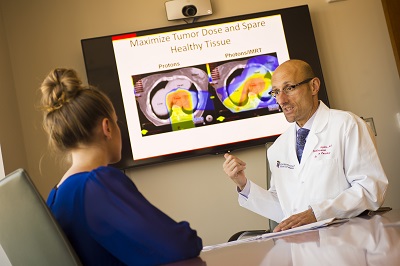We are proud to offer a well-round, robust, and flexible curriculum for resident trainees. Thirty-four to 36 of the 48 months of residency will be spent in required core clinical rotations. The remaining months will be used for elective time and laboratory or clinical research. Ten months are dedicated for professional development time/ research for third year residents, with the option to extend to 12 months. This time may be used for research, either clinical or basic. Alternatively, this time can be utilized for advancing other domains of knowledge, either within radiation oncology or in other areas such as palliative care or population health.
Teaching Format
 Teaching is carried out through didactic lectures, clinics and numerous teaching conferences, with emphasis on patient care, under the supervision of full-time faculty. Elective time is spent in related oncological specialties to promote the multidisciplinary concept of managing cancer patients. The department enjoys state-of-the-art equipment and operates several sites both on- and off- campus, which include: a main facility in the Gudelsky Tower of the University of Maryland Medical Center, the Maryland Proton Treatment Center (MPTC) in downtown Baltimore, the Central Maryland Radiation Oncology (CMRO) center in Columbia, the Kaufman Cancer Center at UM Upper Chesapeake Health in Bel Air, the Tate Cancer Center at UM Baltimore Washington Medical Center (BWMC) in Glen Burnie, the Requard Radiation Oncology Center at UM Shore Regional Health in Easton, and UM Capital Region Health in Largo, MD. The majority (90%) of training is completed at UMMC and MPTC, with select rotations at our CMRO and UM BWMC community sites.
Teaching is carried out through didactic lectures, clinics and numerous teaching conferences, with emphasis on patient care, under the supervision of full-time faculty. Elective time is spent in related oncological specialties to promote the multidisciplinary concept of managing cancer patients. The department enjoys state-of-the-art equipment and operates several sites both on- and off- campus, which include: a main facility in the Gudelsky Tower of the University of Maryland Medical Center, the Maryland Proton Treatment Center (MPTC) in downtown Baltimore, the Central Maryland Radiation Oncology (CMRO) center in Columbia, the Kaufman Cancer Center at UM Upper Chesapeake Health in Bel Air, the Tate Cancer Center at UM Baltimore Washington Medical Center (BWMC) in Glen Burnie, the Requard Radiation Oncology Center at UM Shore Regional Health in Easton, and UM Capital Region Health in Largo, MD. The majority (90%) of training is completed at UMMC and MPTC, with select rotations at our CMRO and UM BWMC community sites.
 There are many intradepartmental and interdepartmental conferences and tumor boards to attend. It is essential to the success of our teaching program that our residents attend all departmental conferences and all interdepartmental conferences appropriate for each rotation. They are designed to teach all levels of trainee, and accomplish important patient care functions on a daily basis. Residents are blocked from clinical duties during all teaching conferences.
There are many intradepartmental and interdepartmental conferences and tumor boards to attend. It is essential to the success of our teaching program that our residents attend all departmental conferences and all interdepartmental conferences appropriate for each rotation. They are designed to teach all levels of trainee, and accomplish important patient care functions on a daily basis. Residents are blocked from clinical duties during all teaching conferences.
All of our clinical faculty are committed to education and participate in the residency program.
Click here for a Sample Teaching Conference Schedule
A few highlights from our teaching format include the following:
- Clinical lectures
- Attending lectures
- Case-based learning
- Visiting Professors (four to six per year)
- Workshops/ hands-on learning
- Hands-on brachytherapy workshop
- Hands-on hyperthermia workshop and the Hyperthermia Therapy Practice School
- Fiberoptic flexible nasopharyngoscopy
- Physics lecture series
- Radiation biology lecture series
- Designated biostatistics sessions (once/ month)
Board Preparation & Educational Courses

Residents have access to our full array of national and international educational courses and events. Every resident in our training program practices a series of “mock” oral examinations as part of their training. After graduation, residents are invited back to the University of Maryland for a dedicated internal mock orals review with faculty disease site experts prior to taking their oral board exam.
The University of Maryland Department of Radiation Oncology sponsors a national Physics and Radiobiology Review Course every year. The course is designed for residents preparing for their board exams as well as radiation oncology physicians preparing for their re-certification exams.
Residents also have the opportunity to participate in the didactic lecture portion of the University of Maryland Department of Radiation Oncology national Mock Orals Course. This course simulates a radiation oncology oral board examination with internal and external disease-site experts reviewing high yield cases and providing practical tips.
Each year, residents are invited to the Radiation Oncology Symposium - Best of course. This is a CME accredited course that provides the attendees with the new changes in technology and treatment modalities that have occurred in the past year. This includes the latest developments in treating the following cancers: genitourinary, head & neck, central nervous system/pediatrics, gynecologic, gastrointestinal, breast, thoracic/SBRT and lymphoma. Residents are given access to the didactics from each of these national courses.
Third- and fourth-year residents are given the opportunity to attend the ASTRO Annual Refresher Course, and attendance is sponsored and supported by the department.
From September through May, all residents are granted protected time to attend the dedicated physics lecture series and the radiation and cancer biology lecture series conducted by our own internal faculty experts as well as faculty from other institutions in preparation for their boards. Sample schedules are shared below.
Sample Physics Lecture Schedule
Sample Radiobiology Lecture Schedule
Annual In-Training Examination
The American College of Radiology administers an in-training examination to residents in Radiation Oncology annually. We require all residents to take this examination.
The in-training examination is used to gauge individual resident learning trajectory, and helps measure the effectiveness of our training program. The exam is not used as the only measure of a resident’s success. In-training examination scores will never be the sole factor for failing to promote a resident to the next level of training, or for expulsion from the program.
